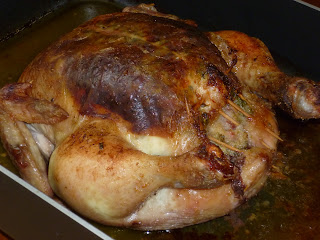It's been nearly 6 months since I took the challenge to cook recipes from the Cooking Class cookbook. I've not quite been keeping up with my challenge of cooking 105-odd recipes in 52 weeks, as life has been getting in the way.
Anyway, Christmas is a good time for cooking and it's been an opportunity to cook from the Cooking Class cookbook, particularly as Christmas means visitors coming to eat. Today saw D's grandparents come over for lunch, so a quick look at the cookbook found an old favourite located on Page 7, namely the French Herbed Chicken. This is a great variation on the traditional roast chicken with stuffing, where the chicken is roasted 'French-style' with herbed butter stuffed under the skin of the chicken breast.
Making the French herbed chicken is easy. First, get a good, free-range size 15 chicken (we used a size 18 chicken) and prepare the chicken breast by gently easing the chicken skin away from the breast meat with a teaspoon (rounded side up), making sure not to break the skin. Once you've done that, preheat the oven to 200 degrees Celcius.
A picture of the chicken in a state of rawness
Step One involves making the herbed butter. First, rest 90 grams of butter at room temperature. Roughly chop the butter and add it into a food processor, along with 2 tablespoons of chopped parsley and 3 finely chopped shallots along with 1 teaspoon of french mustard, 1/2 teaspoon of tarragon along with salt and pepper. Process everything together until combined. Then spread the herbed butter with a small spatula or spoon beneath the skin to cover the whole chicken breast.
The bacon, onion and butter for the stuffing mixture cooking in the pan
Step Two is preparing the stuffing. The recipe calls for 2 1/2 cups of breadcrumbs (but I would say 1 1/2 cups of breadcrumbs is enough to stuff the chicken) in a bowl along with 1 egg, 1/2 teaspoon of thyme and 2 tablespoons of chopped parsley. Then heat 60 grams of butter in a frypan, add 2 rashers of bacon, chopped and 1 small peeled and chopped onion. Saute everything in the pan until the onions are soft. Add this to the crumb mixture and mix well, seasoning with salt and pepper. Stuff the mixture into the chicken and close the cavity with toothpicks.
The chicken in a state of readiness for cooking
Step Three is getting the chicken in the oven. Put the chicken in the baking dish and add 1 cup of dry white wine (I used some Grampians Estate's Garden Gully Riesling), 1/2 cup of water, 30 grams of butter and one chicken stock cube. Bake the chicken uncovered in the oven for 1 hour and 50 minutes or until cooked, basting frequently with pan juices.
Taking the chicken out of the oven begins Step Four. Take the chicken out of the baking dish and let it rest before carving. This will give you the time for making the sauce. Heat up the pan juices in the baking dish and bringing it to the boil for two minutes, then remove from the heat. Stir in 1/2 cup of cream and 1 tablespoon of cornflour. Return to heat and stir until sauce boils and thickens. Season with salt and pepper. Carve the chicken and serve with the stuffing and a selection of roast vegetables and steamed vegetables. Don't forget the put on the sauce either. It was delicious and should serve 4-6 hungry people. The chicken served 4 people today with meat left over for later on.
The chicken cut up and ready to be served


















